
26 minute read
Study on a New Oxidation Stability Method for Lubricating Greases by Employing the Rapid Small Scale Oxidation Test
George S. Dodos ELDON’S S.A.
Abstract
In recent years an accelerated oxidation test has been developed and was initially introduced as a standard ASTM method for screening the ageing reserve of fuels and biofuels. This is namely the Rapid Small Scale Oxidation Test (RSSOT) which is based on an automated and customizable oxidation tester that could be also adapted for measuring lubricating greases. Therefore, the aim of this study is to evaluate the RSSOT as a new potential method for screening the oxidation stability of lubricating greases. Different types of commercially available conventional and biobased grease samples were examined and were subjected to accelerated oxidative deterioration in the RSSOT unit under a series of testing protocols by modifying either the temperature, the oxygen pressure or the final breakpoint. By varying the test parameters, alterations in the relative oxidative characteristics of the samples were determined as well. A comparative assessment was carried out with the results obtained from the ASTM D942 method. The RSSOT can give a rapid screening of a grease’s aging resistance while the results seem to be consistent and in good agreement with the conventional test. Overall, it appears to be a promising method for the determination of the oxidation stability of lubricating greases that can be used as an alternative to conventional ones with certain advantages over the latter.
Keywords: Lubricating greases, oxidation stability, test method, Rapid Small Scale Oxidation Test (RSSOT).
Introduction
The ability of a lubricant to resist to thermal and oxidative deterioration is considered a key feature for an extended useful life and an untroubled service life. This is for certain the case for lubricating greases as well. The need to control and measure the oxidative behaviour of greases, has led to the development of several standard methods that evaluate oxidation stability either under dynamic or static conditions [1-5]. Nowadays, of the so-called static accelerated oxidation stability test methods ASTM D942 and ASTM D5483 are most commonly described in various grease specifications.
The ASTM D942 is the standard method for measuring the Oxidation Stability of Lubricating Greases by the Oxygen Pressure Vessel Method (OPVM). Widely known as the “bomb” oxidation method (Norma - Hoffman), this test was originally designed to predict shelf storage life of greases in pre-packed bearings and was introduced to the ASTM in 1938 [1,6]. It determines the resistance of lubricating greases to oxidation when stored statically in an oxygen atmosphere in a sealed system at an elevated temperature. Being the only available oxidation bench test for many years, the “bomb” became an established method for assessing storage and service oxidation stability that served the industry for a long time and is still used to meet various grease specifications. During the years several modification in the procedure have been proposed (such as temperature increase or addition of metal catalyst) however none of them was ever incorporated in the official standard [4,6]. On the other hand the “bomb” method is a time-consuming test with its own limitations. It has received criticism mainly for the very poor precision it has and for the limited validity in predicting oxidation in service life.
The advances in grease technology and manufacturing has motivated the search for an alternative to the ASTM D942. In the early 1990s the U.S. Army developed a new oxidation stability test for lubricating greases based on Pressure Differential Scanning Calorimetry (PDSC) [2], a technique widely used in polymer science. Eventually this was adopted as the ASTM D5482 standard method for measuring the Oxidation Induction Time of Lubricating Greases by PDSC. In general this is a considerably faster method with a good sensitivity and very small sample requirements. On the other hand the fixed and running cost is high, let alone the need for specialized staff. Also the current precision statements cannot fit to all existing makes of equipment and - similar to the “bomb” method - no correlation has been determined between test and service performance [1,7]. Additionally, some product
types (esp. biobased greases) have been found to give results below the marginal value of 10 minutes even at the lowest ASTM recommended temp of 155oC. These two methods, the oxygen “bomb” and the PDSC, had been shown to give good correlation, but only when the same oxidation mechanism occurred [8].
In the meantime, the increasing demand for biobased lubricating greases has also propagated the search for test methods that would be more applicable in this type of renewable products. The joint ELGI- NLGI Biobased Working Group has recently conducted an extensive round robin tests on methodologies for determining the oxidation stability of biobased lubricating greases including the OPVM, the PDSC and the new proposed method, the Rapid Small Scale Oxidation Test (RSSOT) [9].
The Rapid Small Scale Oxidation Test (RSSOT) - A new potential method for measuring oxidation stability of lubricating greases.
In recent years a new accelerated methodology was developed for measuring the oxidation stability called the Rapid Small Scale Oxidation Test (RSSOT). This test method was initially introduced as a rapid method to screen the oxidation stability of fuels and biofuels. It has been incorporated in the standard methods ASTM D7545 and ASTM D7525 for middle distillate fuels (diesel + renewable alternatives) and spark ignition fuel (gasoline + alternatives) respectively. Like the ASTM D942 method, this is a test based on determination of oxidation stability via oxygen depletion. The automated oxidation tester comprises of a heating block and pressure vessel in which a small amount of sample is placed (Figure 1).
According to the ASTM D7545 standard method, after the introduction of the sample, the pressure vessel of the apparatus is charged with oxygen to 700kPa at ambient temperature. The test is initiated by rapidly heating the pressure vessel to the selected temperature of 140oC. The pressure in the test apparatus is continuously recorded until it is 10 % below the maximum observed pressure. The elapsed time between starting the heating procedure of the sample vessel and the break point is reported as Induction Period in minutes. (IP-min) [10].
Nevertheless the apparatus can be also set up to measure lubricants and greases as it was reported in a previous published work of the author [11]. in which, a preliminary study has been presented on the applicability of the RSSOT on lubricating greases. The potential of this method on lubricating greases has been shown, along with a good correlation with the conventional ASTM D942 method. In this initial study a gold-plated version of the unit has been used and the grease samples were introduced in the unit via a glass dish identical to the one used in the D942 method. The samples were tested under conditions similar to ASTM D 7545.
In the present study, the previous work is extended by examining the following parameters: • An alternative stainless steel version of the apparatus was employed. • A PTFE dish was used instead of the glass dish. • Oxidation stability of lubricating greases was evaluated under various testing protocols by altering the test temperature, the oxygen pressure and the actual mass of the sample. • RSSOT results were compared with those from ASTM
D942 and ASTM D5483.

Grease samples
Nineteen (19) different samples of lubricating greases were employed in this study in order to assess their stability in the RSSOT accelerated oxidation method. The grease samples are listed in Table 1 that summarizes the thickener type they contain, their main base oil type and the NLGI classification. All samples were finished, commercially available lubricating grease products. Samples BG1 - BG6 are characterized as biobased lubricating greases.
Oxidation Stability in the Rapid Small Scale Oxidation Test (RSSOT)
A Rapid Small Scale Oxidation Test unit (RapidOxy-Anton Paar) was utilized in order to assess the oxidation stability of the lubricating greases (Figure 2). As reported above, this is an automated and customizable tester comprising fundamentally of a heating block and a pressure vessel (chamber) that carries the test sample. The latter is subjected to accelerated deterioration under the effect of temperature and oxygen and the oxidation stability is determined via oxygen consumption.
Each time a PTFE sample dish of 9cm3 (9ml) capacity was fully filled with the lubricating grease in a uniform layer with a smooth upper surface. A steady-volume approach was followed so approximately 9cm3 of grease was inserted in the dish. The latter was placed in the test chamber which was then charged with oxygen and heated rapidly per the selected parameters. The samples were subjected to accelerated ageing until a 10% pressure drop below Pmax was detected (breakpoint). The elapsed time between starting the heating procedure and the break point was reported as Induction Period in minutes (Figure 3). All measurements were conducted at least in duplicate.
Effect of temperature
The relative oxidative behaviour of the grease samples in the RSSOT was examined under a series of testing protocols (TP) as listed in Table 2. The main variations in the conditions relate to test temperature and the breakpoint. Temperatures of 100oC, 120 oC, 140 oC, 150 oC and 160 oC were applied, while in one case an extended break point, equal to 25% pressure drop was employed. TP1 is equivalent to ASTM D7545 standard method for middle distillate fuels and TP-7 was used in order to simulate the parameters of ASTM D942 standard method with a breakpoint set to 35kPa [12].
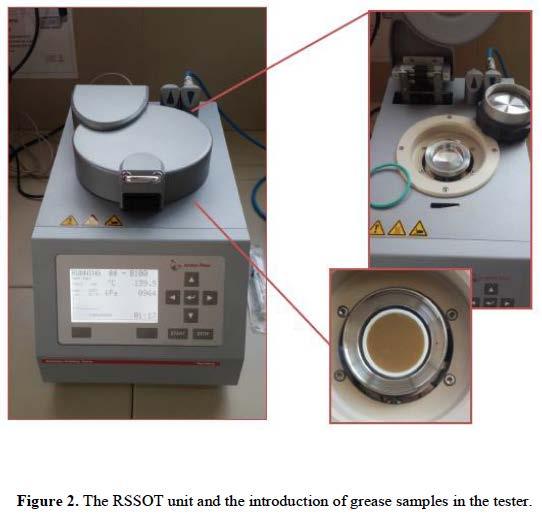
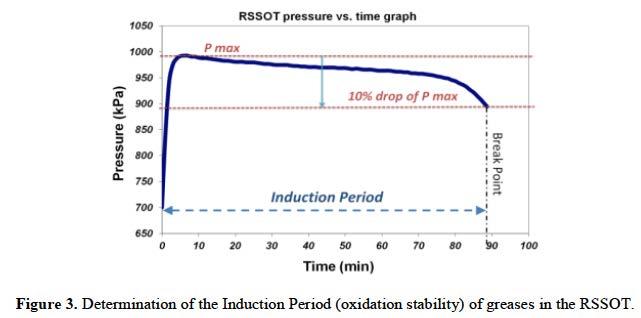
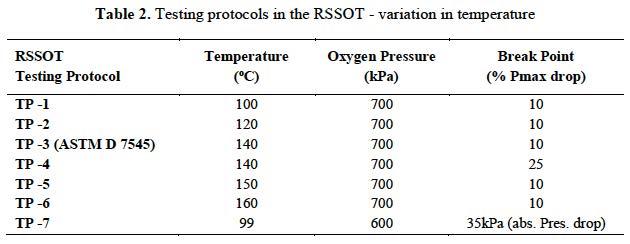
Effect of oxygen pressure
The effect of the initial oxygen pressure in the test chamber with regards to the depicted induction period was evaluated. One of the samples (BG6) was tested under increasing increments of pressure at a temperature of 100 oC and 140 oC as shown in Table 3. Testing protocols 8-10 and 11-13 were compared with results from TP-1 and TP-3 respectively.
Effect of the O-ring seal type
During the test, the pressure chamber is closed hermitically via an O-ring type seal. Since there are two types of available sealing (standard rubber type and PTFE type) that can be utilized, a comparative assessment of the results obtained by using either O-ring type was carried out. Again, one of the examined greases (BG5) was subjected to oxidative deterioration under the testing protocols in Table 1 , by using each time a different type of sealing.
Steady volume vs. steady mass approach - Effect of sample mass
All the previously mentioned testing protocols were conducted on a steady volume basis i.e. by inserting each grease in the PTFE dish in such a way that the latter was completely filled (9cm3) with a sample having a smooth, even finished surface. In order to examine the effect on the reported Induction Period of the quantity of the grease that is placed in the PTFE dish, samples were tested again under TP-3 (140oC, 700kPa, 10% break point), but this time a pre-determined fixed mass of 5g was placed in the dish.
Results and Discussion
The oxidative behaviour of the examined greases under the various testing protocols (TP1 -TP7) in the RSSOT apparatus are given in Figure 4.
The analysis of the data show that the RSSOT can give a

rapid screening of a grease’s oxidation stability compared to the conventional oxygen pressure vessel test. (ASTM D 942). When tested at temperatures higher than 120oC, and with a breakpoint at 10% pressure drop, all determinations were terminated at less than 24h. The results obtained in this study appear to be consistent and reasonable and the method seems to provide good sensitivity and discrimination between the different products. Only TP -7, that was used in order to simulate conditions similar to ASTM D942, was not capable of producing reasonable oxidation stability data.
The increase in the temperature clearly increases the oxidation rate of the samples and subsequently the induction periods are gradually reduced. However test temperatures above 140oC, are more suitable for grease with higher thermal stability since these severe conditions in some cases exceeded the dropping point of some sample, leading to their liquidation during the test.
The order of increasing oxidation stability was found to be more or less similar under the various test conditions with the exception of grease sample G8. This was the only sample that showed a different behaviour when the breakpoint of the test was increased from 10% to 25% pressure drop. For some reasons in this particular sample the oxidation rate is higher in the beginning, however afterwards it appears to proceed extremely slow as depicted by the remarkably elongated induction period in TP-4. Nevertheless, regarding the conventional greases, the calcium sulphonate complex samples and the synthetic-based Li complex proved to be the most
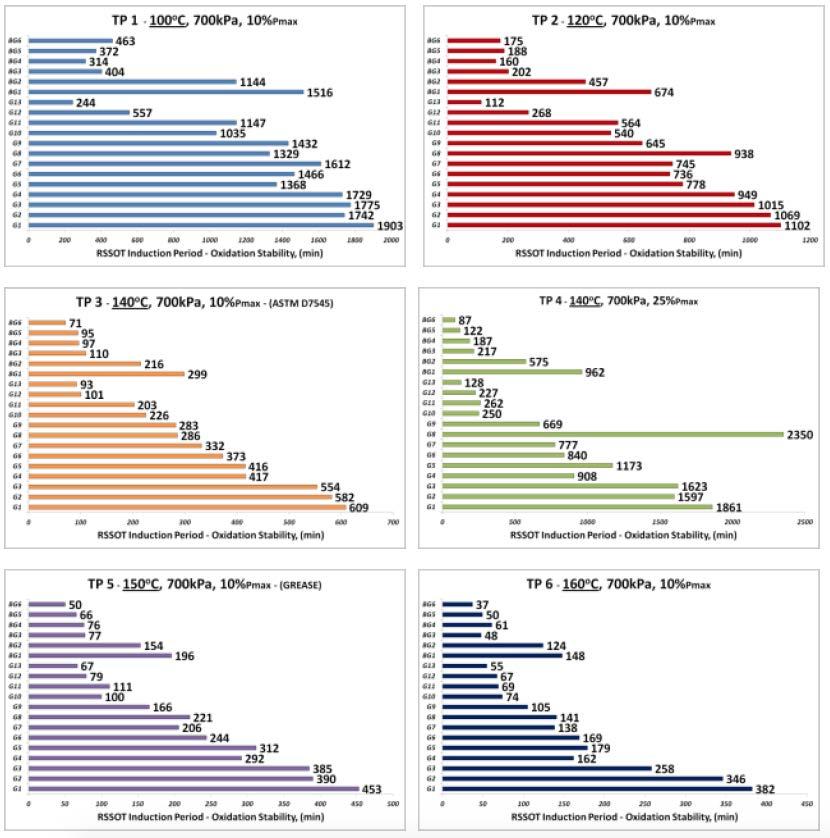
resistant to oxidative deterioration, whereas the hydrated calcium and inorganic clay grease were the least stable.
Concerning the biobased examined samples, it appears that this method could be applicable in this type of greases. It can give a quick estimate of their ageing reserve, it can differentiate between the different types of biobased material utilized (vegetable oils / biobased esters) and could be utilized for R&D purposes for developing more efficient and resistant renewable products. As a matter of fact it is worth noticing that by employing the RSSOT method a direct comparison of the oxidation stability of biobased greases to conventional ones can be directly done, without any discrepancies due to sensitivity limits as shown in PDSC testing.
Effect of temperature
The effect of temperature in the oxidation stability measurements in lubricating greases is given in Figure 5, in terms of the average percentage reduction in the Induction Period (ΔIP%). The behavior of the greases under elevated oxidizing temperature was also examined by visually observing the relative alteration in the appearance of the samples after the test. Such an example is demonstrated in Figure 6 regarding sample BG5. An increase by 10oC in the test temperature led to a 30%, in average, drop in the oxidation stability. A halving in the induction period was observed when temperature was increased by 20oC. When temperature was 30oC and 40oC higher, the decrease in the IP was in average 67% and 75%, respectively. IP was substantially suppressed by further increasing the test temperature.
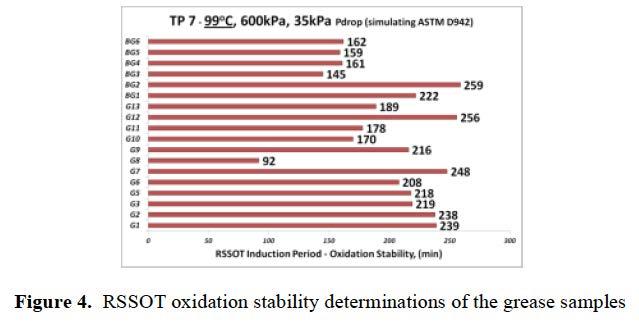
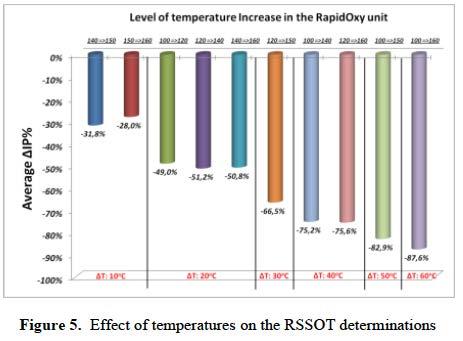

The selected test temperature also affects the corresponding maximum oxygen pressure (Pmax) in the test chamber. In Table 4 the average Pmax for each testing protocol (TP1-TP6) is reported along with the calculated standard deviation (SD). As expected, Pmax increases with the increasing test temperature, however, taking into account the SD values, in practice it appears to be unaffected by the type of the lubricating grease.
This means that irrespective of the grease sample, the Pmax would be more or less the same for each given test temperature and consequently the 10% (or 25%) pressure drop would reflect a comparable difference in the absolute pressure drop. Nevertheless, when the test temperature is plotted against the average Pmax a strong linear relationship is observed, as depicted in Figure 7.
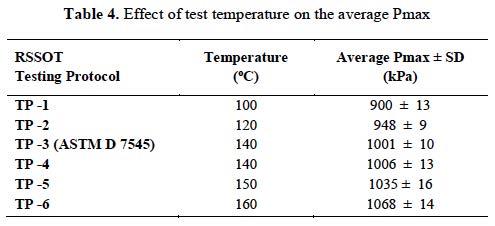
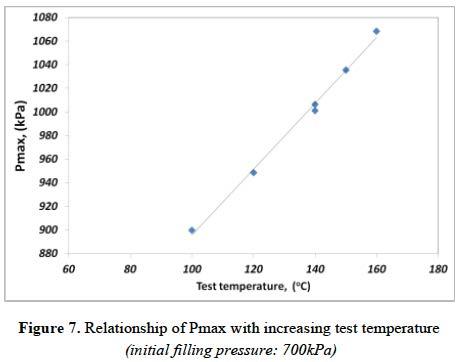
Effect of oxygen pressure
The effect of the applied oxygen pressure on the induction period is given in Figure 8. BG6 grease samples was tested at a range of decreasing pressure increments at test temperatures of 100oC and 140oC. It is evident that the pressure as a test parameter may play a role in the oxidation rate of this grease depending on the test temperature in the RSSOT method. At 140oC the induction period doesn’t seem to be affected by the oxygen pressure and, thus, the variation in the results is not significant. On the contrary when the same sample was tested at a lower temperature of 100oC, the initial filling pressure considerably affected the outcome. In particular, with decreasing pressure increments, a gradual reduction in the induction period was observed, though one might expect either the opposite or at least a minimal effect. The mild test temperature along with the breakpoint approach that is determined as a percent rather than as an absolute pressure drop could explain this behavior.
Effect of sealing type
A similar observation was made when measurements were carried out by using the two different types of the O-ring sealing. As shown in Figure 9 one grease sample (BG5) was tested under various testing protocols and in all cases the IPs were found to be more or less identical, irrespective of the type of seal that was employed.
Fixed volume vs. fixed mass approach - effect on the IP
When the PTFE dish is completely filled with the examined grease, the volume of each sample is constant (9cm3) but depending on the specific gravity of the sample, a slight variation in the inserted mass can be observed. Table 5 shows the mass of each grease when the measurements of all previously reported determinations were carried out under TP 1-13 (approach A - fixed volume). In most cases a quantity of approximately 8g was needed to completely fill the PTFE, except for G1, G2 and G6 in which the volume of 9cm3 corresponds to approximately 9g of sample in the dish.
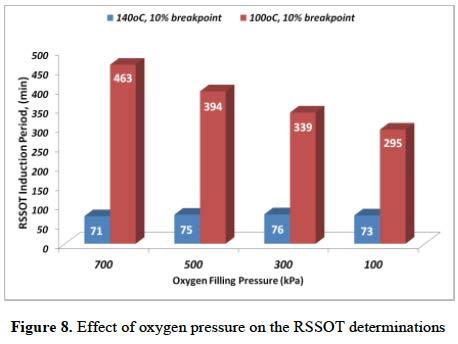
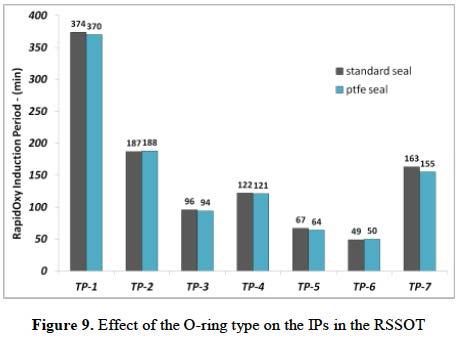

In order to examine how the determined induction periods in the RSSOT are affected when a steady-mass approach is followed, the grease samples were re-run under TP-3 test conditions but this time the PTFE dish was filled with 5g of each grease (approach B). Figure 10 shows the difference in the preparation of the sample to be examined under the steady volume vs. steady mass approach.
The results that were obtained from the steady-mass approach are presented in Figure 11 and compared with the corresponding measurements from the steady volume determinations. Though the 5g sample preparation results in a relatively larger outer surface of the sample that is in direct contact with the oxygen, the lower mass appears, in general, to give rise to elongated induction period. At low IPs, i.e. ≤ 100 min, the determinations were not significantly affected by the quantity of the sample employed and the results were comparable between the two approaches. On the other hand, as the relative oxidation stability increases, considerably higher induction periods are generated at the 5g sample approach. This indicates that the quantity of the sample that is inserted in the PTFE dish plays an important role in the time that is needed to achieve the pre-determined breakpoint of the test. Nevertheless, the fixed mass approach doesn’t seem to substantially alter the observed order of stability of the tested greases compared to the fixed volume approach. The corresponding IPs are plotted in Figure 10 (b) and with the

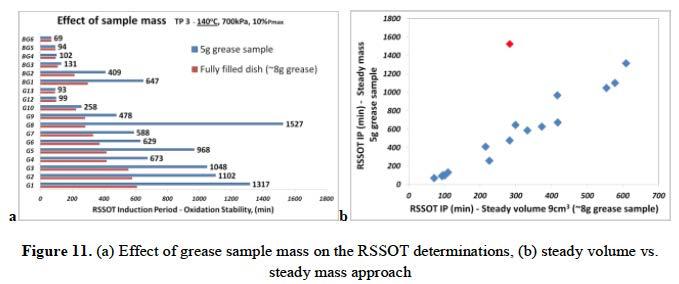
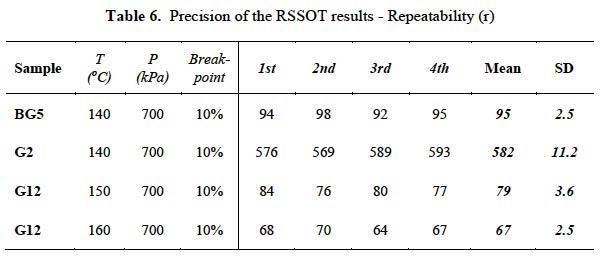
exception of G8 (red dot) - that has a distinct behaviour as it was previously mentioned - the scatter implies more or less an analogous trend in the oxidation stability classification.
Repeatability of the RSSOT method
Repeatability (r) is a standardized term and it is associated with the precision of measurements generated on the same material using the same apparatus/method by the same operator under constant operating conditions. For a method, a satisfactory test-retest reliability should be demonstrated so as to have the potential of being widely acceptable.
Since RSSOT is not a standard method for measuring the oxidation stability of lubricating greases, no pre-determined precision values are yet available. Subsequently a preliminary evaluation of the repeatability was performed. At first, it should be noted that the results shown in Figure 8 can provide an initial perspective of the very good precision of the RSSOT method. In addition to this, a series of grease samples were repeatedly subjected to accelerated oxidative deterioration in the RSSOT under identical conditions in order to further examine the repeatability of the method. The determinations are shown in Table 6 along with the calculated mean and standard deviation (SD) values. These first experimental outputs depict the very good repeatability of the measurements and could be characterized as encouraging concerning the precision of the RSSOT on grease testing.
Reproducibility of the RSSOT method
Similarly to repeatability, reproducibility (R) is also a standardized term relating to the precision of a method under conditions where results are obtained with the same method on identical test items in different laboratories with different operators using different equipment. The ability of a test method to be replicated with a high level of agreement is important for its credibility to provide universally acceptable results. In order to examine whether the oxidation stability measurements of lubricating greases in the RSSOT are reproducible, seven (7) lubricating grease samples were also analyzed in an independent laboratory (lab-2) , by another operator under the same test conditions. The samples were subjected to oxidative deterioration in an identical RSSOT unit (RapidOxy with stainless steel chamber) under TP-3 (140oC, 700kPa, 10% break point). Oxygen of equal purity was employed while 5g of the sample was inserted each time in the PTFE dish. The results that were generated by the two independent laboratories are depicted in Figure 12. A high degree of agreement between measurements is clear in this tentative assessment which can be regarded as a good evidence of the ability of the RSSOT method/unit to provide consistent results.
Comparison of RSSOT with conventional oxidation stability standard methods
In the previous section the ability of the RSSOT method to provide rapid, reliable and consistent results was displayed. In order to check to what extend these data compare with results provided by the standard ASTM method for oxidation stability of lubricating greases, some of the examined samples, were analyzed per ASTM D942 - OPVM methodology and ASTM D 5483 - PDSC methodology.
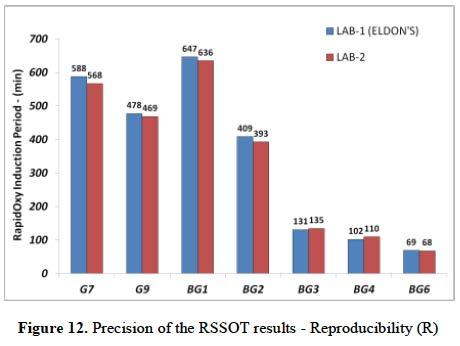
A. RSSOT vs. D942 (OPVM)
Fifteen (15) of the grease samples were tested per ASTM D 942 (99oC, 758kPa, 100h) and the results are presented in Table 7 in terms of the measured oxygen pressure drop after 100h. Exactly the same oxygen grade was used in these measurements as in the RSSOT determinations.
The corresponding data were analyzed using a statistic method and plotted in a graph against the IPs provided by testing protocols (TP) 1 to 6 as presented in Figure 13. Under the examined test conditions, the RSSOT induction periods are in good agreement with the results of the ASTM D942 method. Α satisfactory coefficient of determination (R2) ≥0.91, was observed in all cases. The fact that in both methods the determination of the oxidation stability is based on measuring the oxygen depletion might also contribute to the strength of this relationship. The best correlation was reported for TP-3 where both approaches (steady mass and steady volume) showed a R2 value higher than 0.98. TP-3 test conditions are equivalent to D7545 protocol and this might imply that a temperature of 140oC and a 10% pressure drop breakpoint could be an applicable approach for the case of lubricating greases, as well. A good relationship was also evident in TP-2 (120oC in the RSSOT), however at a lower temperature of 100oC, the data comparison depicted less agreement although this temperature is almost identical with the ASTM D942. The weakest relationship was spotted with TP-6, probably due to the fact that at this high temperature (160oC) the dropping point of some samples is exceeded leading to results that do not actually correspond to a uniform grease formulation.
B. RSSOT vs. D5483 (PDSC)
Twelve (12) of the previously examined samples were

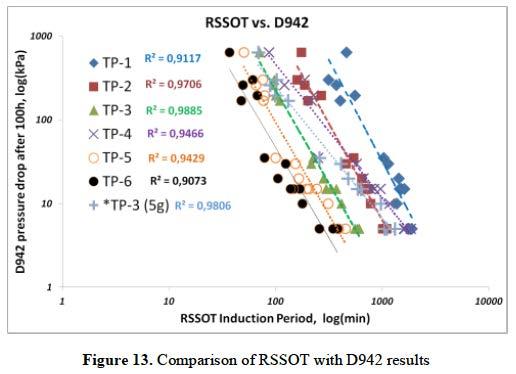

analyzed in a PDSC unit (TA Instruments, Model Q10/Q20) in an independent laboratory. The measurements were conducted according to ASTM D5483 standard method and the oxidation induction time (OIT) of the samples was determined by subjecting them to oxygen of 3.5MPa and temperatures of either 155oC or 180oC. The provided data are listed in Table 8.
At first it is observed that the low oxidation stability greases (G12, G13 & BG5) are either close to the detection limit of the PDSC method, i.e. 10 min, or below this, whereas in the RSSOT even samples with very poor oxidation stability could be rapidly evaluated without such sensitivity limitations. On the other hand grease samples G1 and G2, as excepted, show by far the best oxidative resistance - compared to the rest of the samples - taking into account the considerably elevated OIT values at the higher temperature of 180oC. It is worth noticing that grease G8 failed to return a valid result even at the lower temperature of 155oC, although under all RSSOT testing conditions it was found to be more stable compared at least with G10-G13 and BG-5 samples. In order to examine the relationship between the results obtained from the PDSC unit and the various testing protocols in the RSSOT the samples -except for G8 - were classified per their decreasing order of oxidation stability as demonstrated by the corresponding measurements. The relative classification is given in Table 9. The PSDC data were found to be more close to the classification that was shown by the TP-6 in the RSSOT. It is noteworthy that in this testing protocol the temperature was 160oC which is close to the test temperatures that were employed in the PDSC determinations.
In addition to this, an attempt to explore any tentative existing relationship between these two methods was made. For this reason only the PDSC data that were obtained at the test temperature of 155oC were utilized, since the majority of the samples were not capable of providing results above the detection limit when tested at a higher temperature. The data were analyzed and plotted against the RSSOT determinations as shown in Figure 14. A fair linear relationship could be observed particularly when compared with the TP 3-6 data in the RSSOT, however the TP-1 and TP-2 determinations were not in such a good agreement with the PDSC OIT values as it was in the case of the OPVOM measurements. Nevertheless, this preliminary evaluation indicates a potential for an acceptable correlation between these two methods under certain test conditions and probably similar degradation mechanism to compensate for the different evaluation technique. Clearly, further studies could provide a larger set of data points to show whether PDSC and RSSOT measurements are related either under the standardized test conditions in the PDSC or at a lower temperature and/or pressure.
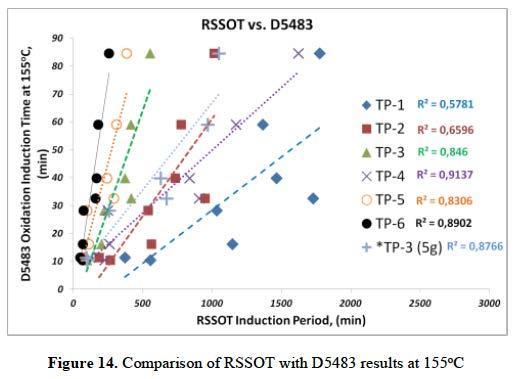
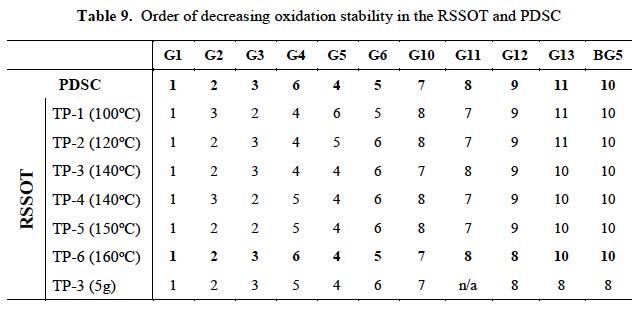
In this study the Rapid Small Scale Oxidation Test (RSSOT) was presented and thoroughly examined as a new potential method for determining the oxidation stability of lubricating greases. A series of nineteen conventional and biobased grease samples were evaluated under various testing protocols and the effect of test parameters - such as test temperature, oxygen pressure and sample mass/volume - on the induction period was assessed. The analysis of the results show that the RSSOT is a rapid method with high sensitivity and good discrimination for different kind of greases, utilizing a small sample with no special preparation techniques and providing customizing capabilities for selecting the optimum test conditions. Additionally, the preliminary examination of the precision provided encouraging data regarding the potential repeatability and reproducibility of this new oxidation methodology on greases. Under the test conditions employed, the induction periods that were obtained by the RSSOT method depicted high degree of agreement with the results of the ASTM D942 (OPVOM) method and a fair relationship with the PDSC data was reported for certain test conditions.
The RSSOT could also be more adaptive in the case of low oxidation stability lubricating greases and this might pose an advantage over both ASTM D942 and ASTM D5483 method, especially for measuring the ageing reserve of biobased greases. Moreover, it could serve as a fast method for production control, process optimization and R&D activities. The sample obtained after oxidative procedure is enough to combine this method with further analysis such as FTIR, etc. Overall the Rapid Small Scale Oxidation Test appears to be a promising method for the determination of the oxidation stability of lubricating greases that can be used as an alternative to the conventional methods with certain advantages over the latter.
References
1. Rand S.J -Ed. (2003), Significance of tests for petroleum products. - 7th Ed., ASTM International, ISBN: 0-80312097-4 2. Rhee I. (1991), Development of a new oxidation stability test method for greases using a pressure differential scanning calorimetry (PDSC). NLGI Spokesman, 55 (4) 3. Dholakia V.P., Klaus E.E., Duda J.L. (1994), Development of a microoxidation test for grease. NLGI Spokesman, 58 (1) 4. Brandolese E. et al. (1997), An accelerated oxidation stability test for predicting grease behavior under severe dynamic conditions. NLGI Spokesman, 60 (11) 5. Sharma B.K., Stipanovic J.A.(2003), Development of a new oxidation stability test method for lubricating oils using high-pressure differential scanning calorimetry,
Thermochimica Acta 402 6. Chasan D., Kristen U., Haering U., (1985), Four modifications for oxygen bomb testing, NLGI Spokesman, 49 (5) 7. Turner D., Graham J., (2012), ASTM Subcommittee D02.G on Lubricating Grease - Update on Activities 8. Jisheng E, G. et al, (2006), Comparison between PDSC and oxygen bomb test methods for evaluation of grease oxidation stability, Eurogrease, 04 9. Minutes of ELGI - NLGI WG Biobased Greases, 2015 10. ASTM D7545 -14, Standard Test Method for Oxidation
Stability of Middle Distillate Fuels—Rapid Small Scale
Oxidation Test (RSSOT) 11. Dodos G.S., (2014) A New Approach for Measuring
Oxidation Stability of Lubricating Greases, Eurogrease (3), 6-14 12. MIL-PRF-10924G (1998), Performance specification grease, automotive and artillery
Acknowledgments
The author would like to acknowledge Anton Paar ProveTec GmbH for the RapidOxy apparatus used in this study.
The PDSC data were kindly measured and provided by Afton Chemicals, USA. Special thanks to Joe Kaperick for his assistance and contribution to this study.
The contribution of Ian Atha, from Ironsides Lubricants Ltd, UK, is also appreciated for his nice comments on the examined method and for providing the replicate set of RSSOT data (Lab-2).
Abbreviations
ASTM American Society for Testing and Materials BGx Biobased Grease sample ELGI European Lubricating Grease Institute Gx Grease sample (non-biobased) IP Induction Period NLGI National Lubricating Grease Institute OIT Oxidation Induction Time OPVM Oxygen Pressure Vessel Method (NormaHoffman) PDSC Pressure Differential Scanning Calorimetry PTFE Poly-Tetra-Fluoro-Ethylene (Teflon) RSSOT Rapid Small Scale Oxidation Test TPx Testing Protocol
NLGI SPOKESMAN
Be featured in NLGI Member Spotlight!

All NLGI members may take advantage of this opportunity to highlight your company’s history, global reach, vision, employees or whatever you’d like our readership to know about your company. You may talk about products & services, however, no competitor trade names may be used, nor mention of product pricing.
There is no limit on words and we welcome many photos of your headquarters, offices, plant & employee photos. We will accept articles for publication on a first received, first published basis. Contact Denise Roberts denise@nlgi.org at NLGI if you would like to submit an article for possible publication in an upcoming issue.








